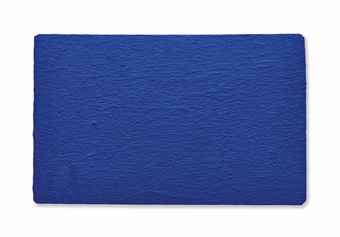Yves Klein (French pronunciation: [iv klɛ̃]; 28 April 1928 – 6 June 1962) was a French artist considered an important figure in post-war European art. He is the leading member of the French artistic movement of Nouveau réalisme founded in 1960 by art critic Pierre Restany. Klein was a pioneer in the development of Performance art, and is seen as an inspiration to and as a forerunner of Minimal art, as well as Pop art.
http://en.wikipedia.org/wiki/Yves_Klein
IKB 15, 1962
International Klein Blue (or IKB as it is known in art circles) was developed by Yves Klein as part of his search for colors which best represented the concepts he wished to convey as an artist. IKB was developed by Klein and chemists at the French pharmaceutical company Rhône Poulenc to have the same color brightness and intensity as dry pigments, which it achieves by suspending dry pigment in polyvinyl acetate, a synthetic resin otherwise marketed in France at the time by Rhône Poulenc as Rhodopas M or M60A.
In May 1960, Klein deposited a Soleau envelope, registering his paint formulation under the name International Klein Blue (IKB) at the Institut national de la propriété industrielle. The patent was published in April 1961.
In March 1960, Klein patented a method by which he was able to distance himself from the physical creation of his paintings by remotely directing models covered in the color.
http://en.wikipedia.org/wiki/International_Klein_Blue
Monochrome bleu sans titre (coulée) (IKB 40), 1956
Patent No. 63471 Issued Paris, May 19, 1960
IKB has been perfected by Yves Klein le
monochrome in the course of the years 1954-55-56-57-58. The current
chemical formula is exactly:
1.2 kilos Rhodopas (paste product) and MA (Rhone Poulenc) (vinyl chrloride)
2.2 kilos ethyl alcohol. 95% industrial, denatured
6.0 kilos Ethyl acetate
A total of 4 kilos
Mix cold while energetically agitating and never heat uncovered!
1.2 kilos Rhodopas (paste product) and MA (Rhone Poulenc) (vinyl chrloride)
2.2 kilos ethyl alcohol. 95% industrial, denatured
6.0 kilos Ethyl acetate
A total of 4 kilos
Mix cold while energetically agitating and never heat uncovered!
Then, mix cold the pure ultramarine blue 1311 in powder with fixative medium, in the proportion of 50%—if one adds 1/10 of the total with pure acetone—and 40%—if one adds pure alcohol.
Absolute Brend
Monochrome bleu sans titre (IKB 27), ca. 1957
The letters IKB stand for International Klein Blue, a
distinctive ultramarine which Klein registered as a trademark colour in
1957. He considered that this colour had a quality close to pure space
and he associated it with immaterial values beyond what can be seen or
touched. The announcement card for his one-man exhibition at the
Galleria Apollinaire, Milan in 1957 described IKB as 'a Blue in itself,
disengaged from all functional justification' (quoted in Stich, p.81).
By this time Klein had arrived at a means of painting in which the
incandescence of IKB could be maximised. First he stretched his canvas
or cotton scrim over a wooden backing, which had been treated with a
milk protein called casein. This assisted the adherence of the paint
when it was applied with a roller. Then he applied an industrial blue
paint, similar to gouache, which he mixed with a highly volatile
fixative. When the paint dried the pigment appeared to hover over the
surface of the canvas creating a rich velvety texture and an unusual
appearance of depth.
The production of monochrome paintings was probably
conceived by Klein as both a spiritual and a marketable activity. At his
1957 exhibition in Milan, he displayed a series of eleven ostensibly
identical blue monochromes, each with a different price which he claimed
reflected its unique spirit. As he explained: 'Each blue world of each
painting, although the same blue and treated in the same way, presented a
completely different essence and atmosphere. None resembled any other -
no more than pictoral moments resemble each other - although all were
of the same superior and subtle nature (marked by the immaterial) … The
most sensational observation was from the "buyers". They chose among the
eleven exhibited paintings, each in their own way, and each paid the
requested price. The prices were all different, of course.'
Sophie Howarth
Something that tends to be forgotten about Klein is the controversy his work produced at the time it was exhibited. While the more materially tangible parts of the Klein oeuvre have been subsumed into the ‘spiritual in art’ debate over the last decade, his contemporaries viewed much of his activity with a certain degree of scepticism. This is equally evident amongst Klein’s close friends and the artists he worked with, as Jean Tinguely described:
‘It was his personality which prevented him from being taken too seriously. He was too alive. An artist cannot be so charming, so powerfully persuasive; an artist can’t articulate ideas that well. It was almost inconceivable that an artist could be like Yves Klein.’
This is a fatal mixture: Klein as visionary cut with Klein the mover and shaker, unapologetic self-publicist and creative documentor. Yet, it is perhaps one of the most significant aspects of this mix that Klein has unwittingly become the role model for a particular type of artist. There is something familiar in the activities of Jeff Koons, for example. For both of them, the artist somehow takes on an privileged role: Koons gets to butt-fuck an Italian Member of Parliament in the fantasy world of a porno set; Klein, dressed in white tie and wearing the Order of Saint Sebastian, got to touch-up paint-covered girls to an orchestral accompaniment in front of an audience of Parisian socialites. Only the means are different: whereas Koons is able to co-opt the authority of the media, Klein worked with a different vocabulary - that of official hierarchy (political, social or artistic) and its paraphernalia.
James Roberts
http://www.frieze.com/issue/review/yves_klein/






No comments:
Post a Comment